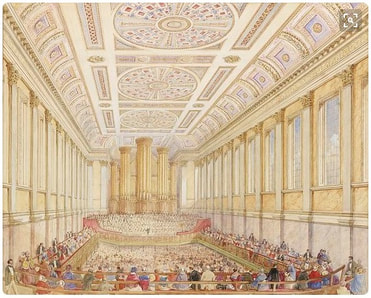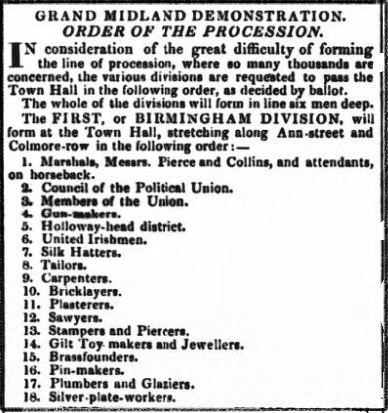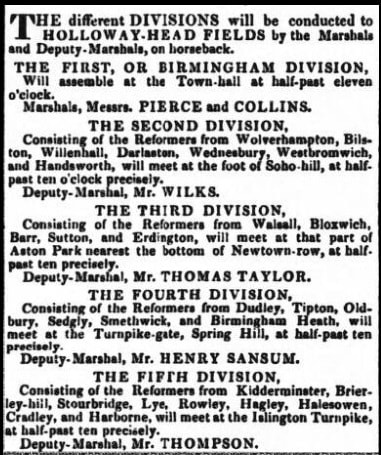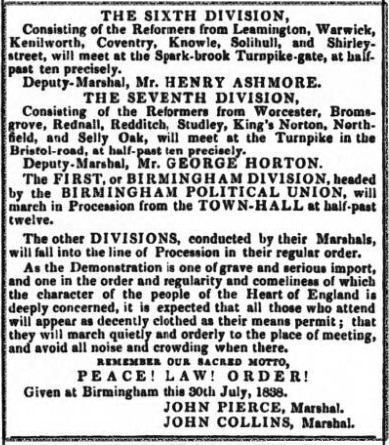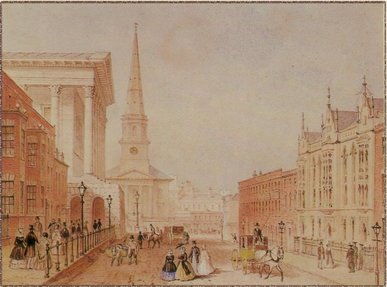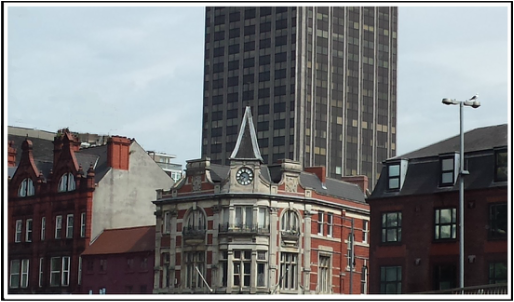AUGUST 1838 - HOLLOWAY HEAD
Great Midland Demonstration
The Great Midland Demonstration took place on 6th August 1838 in the fields at the foot of Holloway Head in the Ladywood area of Birmingham, England. Attended by a "crowd of 200,000 people" (Hovell, The Chartist Movement) the demonstration marked the official launch of the Chartist Movement, being the first large scale working class movement in Great Britain. It was at the Great Midland Demonstration that the National Petition was presented, adopted, and signed by thousands of people in readiness to petition the Government.
The National Petition in favour of the People's Charter called for five main principles of electoral reform, including:
The National Petition in favour of the People's Charter called for five main principles of electoral reform, including:
|
- Universal Suffrage for men over the age of 21 years
- No property qualifications to stand for Parliament - Annual elections for Parliament - Equal-sized electoral districts - Members of Parliament to be paid - Voting by secret ballot |
The Call to come Forth in Strength
The Great Midland Demonstration was brought about by the Birmingham Political Union which called on the inhabitants of Birmingham and the surrounding Midland Districts to attend a public meeting at Holloway Head, the purpose of which was to:
present the National Petition for more signatures; elect delegates to attend a General Convention; to carry the five principles of the Petition into law; and ask other towns and districts in the United Kingdom to do the same. The BPU requested employers give their workers time off to attend the meeting.
present the National Petition for more signatures; elect delegates to attend a General Convention; to carry the five principles of the Petition into law; and ask other towns and districts in the United Kingdom to do the same. The BPU requested employers give their workers time off to attend the meeting.
As a trusted and well respected leader of the Birmingham Political Union, John Collins (along with fellow BPU councilor John Pierce) was appointed Joint Marshal of the Grand Midland Demonstration to superintend and conduct the whole of the arrangements. Different bodies of men, as they entered the town, and the place of meeting, were asked to attend strictly to Collins' and Pierce's directions.
|
The Union Meeting Before the Demonstration
The proceedings that day began with a meeting of the Birmingham Political Union in the Town Hall with its huge, cavernous interior being filled to capacity. Some 40-plus council members, including John Collins, were elected to serve the coming year, and of that number a handful were working men, the rest being of the middle class. There was much cheering for them and special guest reformers including Alexander Purdie and James Muir from Scotland, Henry Vincent from London, Fergus O'Connor for Yorkshire, as well as other representatives from towns across the country. |
Once the business of the union meeting was concluded those present formed a line, six deep, outside the Town Hall along Colmore Row and Ann Street. From there the council of the BPU led the mammouth procession through the streets of Birmingham and onto Holloway Head for the Great Midland Demonstration.
Grand Midland Demonstration - Order of Procession - Birmingham Journal 4th August 1838
Procession to Holloway Head
The logistics of the giant procession to Holloway Head - coordinating the numbers and the order of divisions - must have been an awesome task. Figuring out the who, how, where, and when for the participation of a few hundred would be difficult enough, but this was literally for thousands of people all converging on Birmingham for one giant-long procession. There were none of today's forms of communication (radio, TV, email, Facebook and Twitter!) and it would take another fifty years before Alexander Bell introduced the telephone.
John Collins was a hard worker and a highly effective organizer, as was seen in his tour of Scotland where he was pivotal in bringing together the reformers and leaders of Glasgow and Birmingham. He was passionate and dedicated to the cause. Once again he helped ensure the success of this major event leading into the Chartist Movement.
|
The People Come Together
6th August 1839 - In order to avoid confusion each Division consisting several towns taking part in the procession, were requested to assemble at certain locations throughout the town, and to proceed along designated routes where they would fall into line of the main procession.
Each Division passed the Town Hall in their given order, which had been decided by ballot. Everyone was asked to dress appropriately, but within their means, for such a "grave and serious import!" |
Accordingly to the London Courier and the Birmingham Journal an estimated 250,000 people attended the formidable meeting at Holloway Head on that typically English summer day - sunny, breezy but not too hot - and you may wonder how they calculated such a huge assemblage!
In those days Holloway Head consisted a giant, naturally formed amphitheater made up of fields and slopes awaiting further development some time in the future. The hustings (the man-made platform where the speakers and guests stood) reportedly commanded a view over approximately 8-10 acres in the front, with still more acreage forming wings and slopes to the sides and rear of the hustings, and additional ground rising up to a natural platform above the fields.
The whole area was packed with people, and the calculation was based on the number of individuals the known number of acres could hold. And even if a quarter of a million was an exaggeration, there is no doubt that this was a formidable demonstration of public support for franchising the vote to everyone. (The population of Birmingham was reportedly 160,000 per the Birmingham Journal.)
In those days Holloway Head consisted a giant, naturally formed amphitheater made up of fields and slopes awaiting further development some time in the future. The hustings (the man-made platform where the speakers and guests stood) reportedly commanded a view over approximately 8-10 acres in the front, with still more acreage forming wings and slopes to the sides and rear of the hustings, and additional ground rising up to a natural platform above the fields.
The whole area was packed with people, and the calculation was based on the number of individuals the known number of acres could hold. And even if a quarter of a million was an exaggeration, there is no doubt that this was a formidable demonstration of public support for franchising the vote to everyone. (The population of Birmingham was reportedly 160,000 per the Birmingham Journal.)
In addition to speeches, the crowd at Holloway Head (and at other Chartist meetings all over the country) were asked to elect delegates to represent the people at a forthcoming General Convention to be held in London in February the following year. John Collins was officially appointed a delegate to represent Birmingham as well as Northampton, Cheltenham and Coventry. The purpose of the 1839 Convention, which came to be known by the somewhat laborious title of the General Convention of the Industrious Classes was to manage and oversee the affairs of the Chartist Movement, including the presentation of The National Petition to Parliament. The Convention, like the National Petition, was the brainchild of the Birmingham Political Union.
The Great Midland Demonstration was one of the largest, most ceremonial, and certainly well organized political events that Birmingham had ever seen, and after it was over the BPU council and invited guests, including Fergus O'Connor, dined at The Bell on Philip Street, where it turned into a congenial and friendly affair. [Birmingham Journal and the Globe 11 Aug 1838]. And so began The Chartist Movement and the joining of working class radical forces "under the standards of the National Petition and the People's Charter."
Holloway Head - Then and Now
